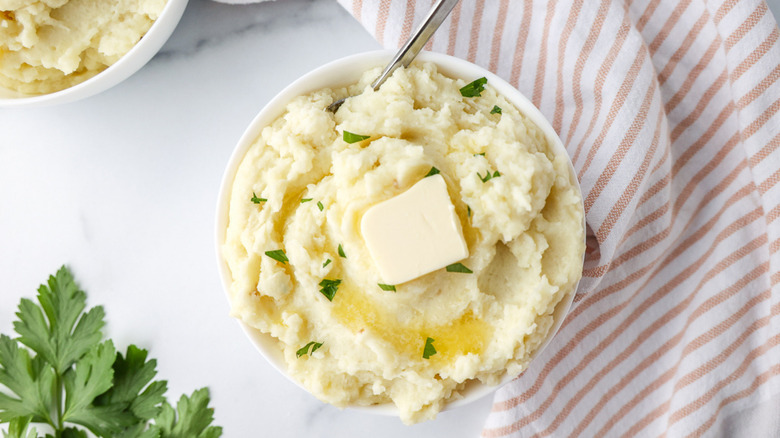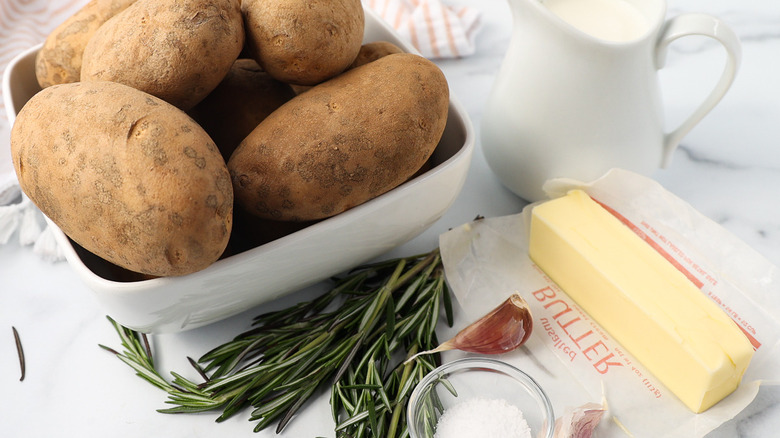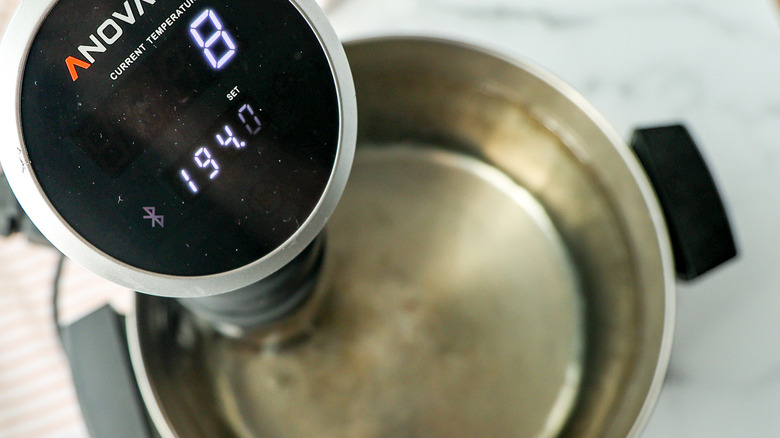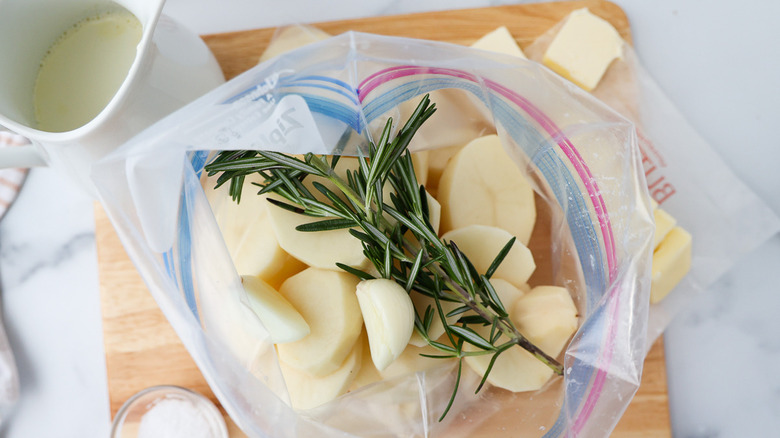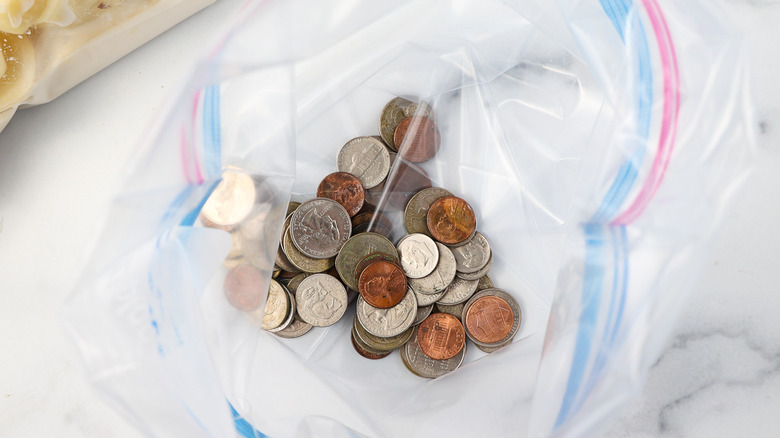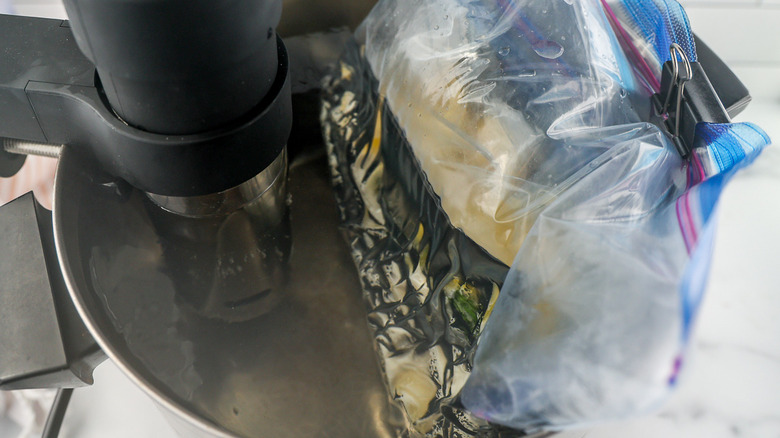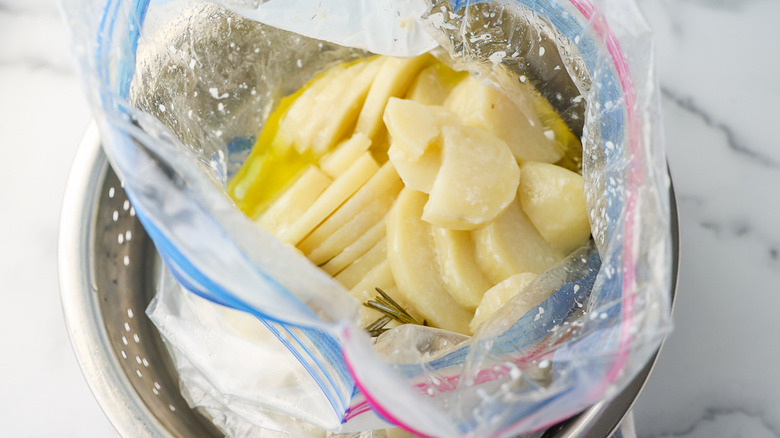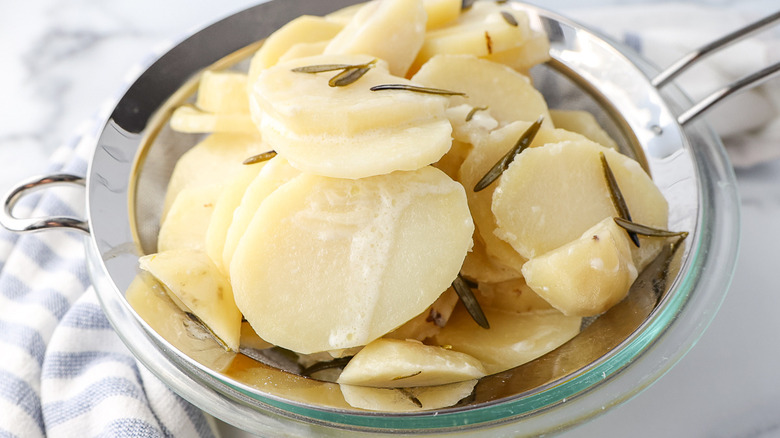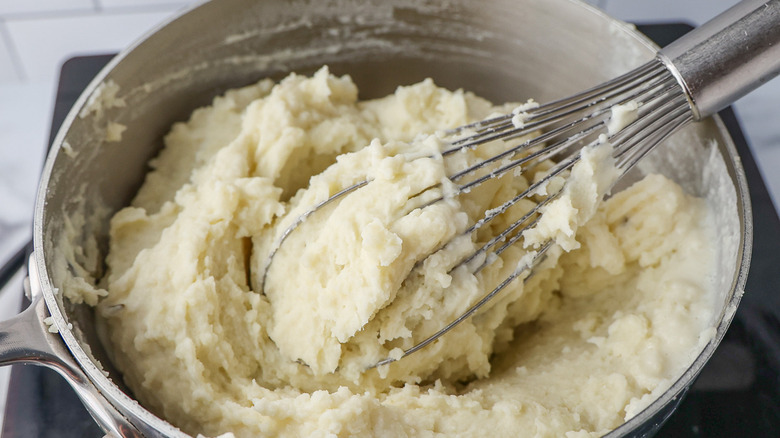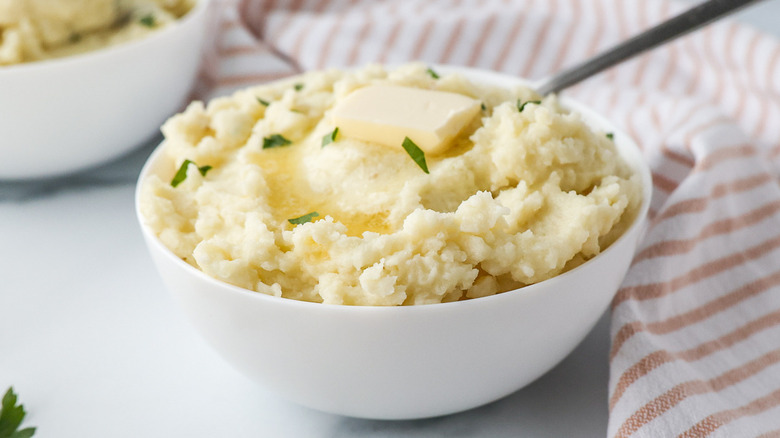Best Sous Vide Mashed Potatoes Recipe
We may receive a commission on purchases made from links.
There's nothing like some good old-fashioned mashed potatoes. While people typically cook mashed potatoes in a pot, there's another way that involves almost no work but still yields a great result: using a sous vide. "Sous vide cooking is about vacuum sealing the food and cooking it at a precise temperature," food blogger and recipe developer Michelle Morey shares. It's high tech for sure, but also surprisingly simple.
"With traditional boiling, a lot of the flavor is lost in the boiling process," Morey shares. "With sous vide, the potatoes are able to absorb the flavors of the butter, cream, and rosemary, without losing any of the natural potato flavor in the process. So this method makes the dish way more flavorful." This results in unique nuance: "I love how the nutrients and flavor of the potatoes are not boiled away," she says. "The potatoes are cooked in tons of flavor and really absorb it!"
Gather the ingredients
The first order of business is to make a grocery list of everything you will need. For starters, grab some russet potatoes and a few cloves of garlic. Additionally, you will need a few items from the dairy section, including heavy cream and whole milk. The recipe also calls for some unsalted butter and kosher salt. If you cook a lot, you may have one or both items at home already.
To complete your list, add a few sprigs of fresh rosemary. If you can't find it fresh, you can always use dried instead. Once you have everything together, it's time to begin.
Prep the sous vide
The first thing you will want to do is to attach a water circulator to the side of a large pot or heatproof container that can hold 8 quarts or more. "The 8-quart pot needs to be filled with water," Morey shares. "Depending on the size of the pot to cook uses, it should be full about ¾ of the way. So I used about 5 to 6 quarts of water for my pot. There will be a rise in the water level once the circulator and the food are added to the water bath. If needed add more water to the pot to get the bag of potatoes totally submerged."
Make sure your pot is on a heatproof surface. Then, set the circulator to 194 degrees Fahrenheit and press start to preheat the water. In a smaller saucepan on the stovetop, warm the milk and cream over medium heat for a few minutes, until it starts steaming. Morey shares that with the milk and cream already warmed up, "when all the ingredients are added to the water bath, in their Ziploc bag, it won't take as long for the water bath to come back up to temperature."
Please note that it should only take about 4 to 5 minutes to heat up the milk and cream — do not let it start boiling.
Slice the potatoes and add to the bag
Now, it's time to grab the russet potatoes. Make sure they are peeled and washed, then slice them. They should be about ¼-inch thick. You'll also want to peel and smash your garlic cloves at this point.
Grab a 1-gallon freezer bag and add the sliced potatoes, garlic, cream and milk mixture, butter, and salt. Last but not least, toss in the rosemary. Be sure to press the bag to get out as much air as possible, then seal it. "Make sure to use good quality FREEZER bags for this task," Morey says. "Cheap bags will bust open during the cooking process."
Grab another bag to weigh it down
Now, take out another 1-gallon freezer bag. You'll want to add pie weights or coins to the bottom to weigh down the bag. This will keep the potato mixture submerged, which is vital for thorough cooking. Gently place the potato bag inside the weighted bag and squeeze out as much air as possible.
"Tip for getting the air out of the bag: add [the] bags to the water, but do not submerge completely," Morey recommends. "Open a corner of the freezer bags, and the pressure from the water will press the rest of the air out. Seal tightly and hold bag in place with a clip to the side of your water vessel."
Add the potato bag to the water
Now, it's time to add the double-bagged potatoes to the water bath. Use either a binder clip or a kitchen clip to attach the bag to the side of the cooking pot. The water must be able to circulate behind and around the cooking bag, so be sure that there's enough room.
Sous viding is all about cooking at a specific temperature, which the circulator helps regulate. "If you didn't use a circulator, you'd need to attach a thermometer and constantly adjust the flame or heat of your stovetop to maintain the proper temperature," she shares.
Sous vide the potatoes
Now, you will want to set your timer for 60 to 90 minutes and cook the potatoes until they are tender. Luckily, there's a trick for checking for doneness. Pinch a potato through the bag to see if it's tender. If it crushes easily, then the potatoes are done cooking, and you can remove them. If not, return to the water bath and continue cooking. It could take an additional 20 to 30 minutes.
When the potatoes are done, carefully remove the hot bags from the water bath with tongs. Pull the potato bag out, holding and opening it away from you as the steam can be really hot.
Pull out rosemary and heat the saucepan
If you used a sprig of rosemary, you can pull it out of the bag with tongs and then put the potatoes in a strainer. Set the strainer over a bowl to catch the liquid — and be sure that you don't discard it.
Then, place a 2 to 3-quart saucepan on the stove and turn the heat to low. Use a ricer or a food mill to process the hot potatoes into the saucepan.
Whisk the liquid
Now, you can pour in the reserved cooking liquid and whisk it into the potatoes. Just add a little bit at a time until you reach the desired consistency. Be sure to whisk the mixture as you go. Feel free to taste the potatoes to see if they need any additional flavor; add salt and pepper if you feel that the potatoes need it. Feel free to store the extra liquid to use in the future for potatoes, soups, or even chowders.
Serve and enjoy
These potatoes are best when served immediately. They go well with several different main dishes but you can also just enjoy them solo. "These potatoes are great served as a side along chicken, pork loin, or even a nice braised short rib," Morey suggests.
We don't think you'll have any leftovers, but you can store them in the fridge for five days if you do.
Best Sous Vide Mashed Potatoes Recipe
Impress your friends and family by making these incredible mashed potatoes using a sous vide method, sealing in delicious flavor and nutrients.
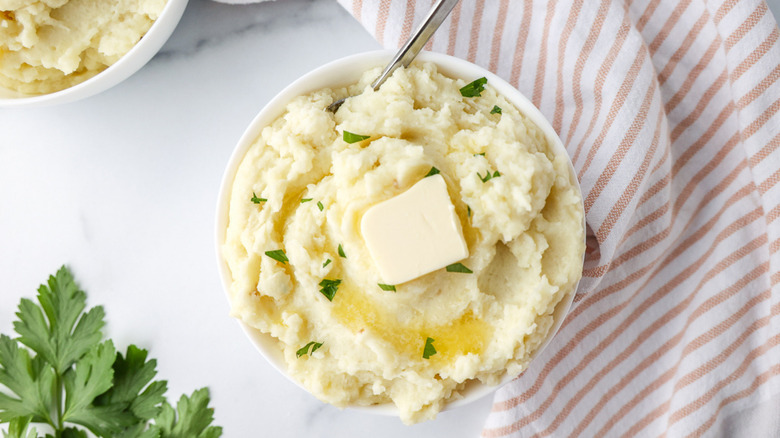
Ingredients
- 1/2 cup whole milk
- 1/2 cup heavy cream
- 2 pounds of russet potatoes, peeled and cleaned
- 2 small cloves of garlic, peeled and smashed
- 1/2 cup unsalted butter
- 1 1/2 teaspoons kosher salt
- 3 sprigs fresh rosemary or 1/2 teaspoon dried rosemary
Optional Ingredients
- fresh chopped parsley, for topping
- butter, for topping
Directions
- Attach a water circulator to the side of a large pot or heatproof container 8 quarts or larger.
- Fill the pot ¾ of the way with water and set it down on a heatproof surface. Set the circulator to 194 F and press Start to preheat the water.
- Meanwhile, warm the milk and cream over medium heat in a saucepan on the stovetop until steaming, about 4 to 5 minutes.
- Slice the peeled russet potatoes about to about 1/4-inch thick.
- To a 1-gallon freezer bag, add the sliced potatoes, garlic, cream, milk, butter, salt, and rosemary.
- Press as much air out of the bag as possible and seal.
- In a second 1-gallon freezer bag, add pie weights (or coins) to the bottom to weigh down the bag.
- Gently place the sealed potato bag inside the weighted bag. Squeeze out as much air as possible and seal.
- Add the double bagged potatoes to the water bath. Use a binder clip or kitchen clip to attach the bag to the side of the pot. Make sure the water can circulate behind and all around the cooking bag.
- Sous vide the potatoes for 60 to 90 minutes until tender. If the potatoes are not tender, return to the water bath and continue cooking.
- Once the potatoes are tender, use tongs to carefully remove the hot bags from the water bath. Pull out the bag holding the potatoes and open it away from you.
- Pull out the rosemary stem (if using fresh) and drain the potatoes through a strainer set over a bowl to catch the liquid. Do not discard the potato liquid.
- Place a small 2- to 3-quart saucepan on the stovetop over low heat.
- Using a ricer or a food mill, carefully process the hot potatoes into the saucepan.
- Next, whisk the reserved cooking liquid into the processed potatoes a little at a time until the desired consistency is reached. Taste and add salt and pepper if needed.
- If desired, top with parsley and butter.
- Serve immediately and enjoy!
Nutrition
| Calories per Serving | 204 |
| Total Fat | 14.2 g |
| Saturated Fat | 8.9 g |
| Trans Fat | 0.4 g |
| Cholesterol | 41.9 mg |
| Total Carbohydrates | 17.8 g |
| Dietary Fiber | 1.4 g |
| Total Sugars | 1.5 g |
| Sodium | 297.9 mg |
| Protein | 2.7 g |
